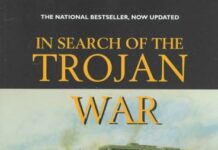
Ebook Info
- Published: 2015
- Number of pages: 365 pages
- Format: PDF
- File Size: 2.98 MB
- Authors: Michael Wood
Description
This edition of Michael Wood’s groundbreaking first book explores the fascinating and mysterious centuries between the Romans and the Norman Conquest of 1066. In Search of the Dark Ages vividly conjures up some of the most famous names in British history, such as Queen Boadicea, leader of a terrible war of resistance against the Romans, and King Arthur, the ‘once and future king’, for whose riddle Wood proposes a new and surprising solution. Here too, warts and all, are the Saxon, Viking and Norman kings who laid the political foundations of England – Offa of Mercia, Alfred the Great, Athelstan, and William the Conqueror, whose victory at Hastings in 1066 marked the end of Anglo-Saxon England. Reflecting recent historical, textual and archaeological research, this revised edition of Michael Wood’s classic book overturns preconceptions of the Dark Ages as a shadowy and brutal era, showing them to be a richly exciting and formative period in the history of Britain. ‘With In Search of the Dark Ages, Michael Wood wrote the book for history on TV.’ The Times ‘Michael Wood is the maker of some of the best TV documentaries ever made on history and archaeology.’ Times Literary Supplement
User’s Reviews
Reviews from Amazon users which were colected at the time this book was published on the website:
⭐This is a rare book that is extensively researched and documented but which gives a sweeping sense of time and history as Michael Wood takes us from the Roman occupation of Britain, followed by the Anglo-Saxon invasions and colonization, through the rise of the great kings that began to unify the island, the establishment of Christian infrastructure, then to the Viking invasions, and finally the invasion of William the Conqueror and the Normans in 1066.Julius Caesar arrived in Britain around 34 BC but a firmer foothold in southern Britain was not established under Roman Control until after the arrival of Claudius in around 43 AD. The Romans met resistance and Wood tells the story of Boudica, the warrior queen of the Iceni tribe, who fights the Romans after the death of her husband. It is the defeat of these Celtic tribes, one by one, that establishes Roman Britannia, the outskirts of the Roman Empire. However by 410 the empire was under considerable stress from invasions from the Franks and Goths and other central European tribes and thus the Romans pulled back from defense of Britain in 410. Roman soldiers who served in the legions for 20 years could retire and were given farm land in defeated nations. Thus there was considerable Roman influence, art, architecture, legal infrastructure, and community organization and infrastructure when the main Roman forces leave.Wood also explores the legend and historical evidence of King Arthur. After the Romans left Britain the remaining Roman influenced kings and leaders had to defend themselves against the invading Anglo-Saxons and Vikings. Wood convincingly demonstrates that Britain was constantly invaded and raided by Vikings for a period of almost 700 years, until the Norman invasion, and King Arthur is believed to have been a British king, influenced in Roman thought and culture, who fights against the Anglo Saxons and Vikings. This would have been around the year 500 when documentation and written accounts were at a minimum and the Celtic missionaries were gaining a Christian foothold in Britain.A chapter is devoted to King Offa who united southern Britain into Mercia, which was quite a task since there were over 40 small kingdoms and Kings spread across southern Britain. Offa’s Dyke, a gigantic earth structure, based upon Roman engineering, is also discussed. It is around this time that Beowulf is written for Offa’s court and St. Bede writes the Ecclesiastical History of England.Alfred the Great, who ruled a unified Anglo-Saxon England, battles the Danish, Norwegians, and Northumbrians in the 800s, a period of national unification but of constant threats. War was the primary method of acquiring wealth and power during this period, so it was indeed a dark age for all involved, especially the lower classes. Alfred was allied with the Christian church which was in conflict with the pagan Scandinavian religion that was brought to England by the invading and then colonizing Vikings. The Anglo Saxon Chronicles are begun during the reign of Alfred and various versions were maintained for several centuries.It is under Athelstan that the Northumbrians are unified with the southern Anglo Saxons and the kingdom of Mercia. But Wood makes it clear that the Vikings are never at rest and the rise of Eric Bloodaxe as Norwegian king of Northumbria brings about another round of conflict. The English nation is further undermined during the reign of Ethelred the Unready and it is due to Ethelred’s marriage to a Norman princess and the exile of his sons as refugees to Normandy that in many ways sets the stage for the Norman invasion of William the Conqueror in 1066. When pious king Edward the Confessor dies without children, Harold Goodwin takes over the throne and would have succeeded had it not been for almost simultaneous invasions of Vikings in Northumbria and Normans in Southern England. Harold defeated the Vikings, killing the Viking king and Harold’s treasonous brother, but then immediately riding south to fight the invading Normans was a recipe for disaster.Wood’s approach of combining anthropology, archeology, ecclesiastical history, and the vast melting pot of cultures that dominate Britain and England from 400 to 1000 makes for very interesting reading and a fascinating interpretation of what life may have been like for those living during this 600 year period.
⭐Excited to find this Michael Wood book previously owned. Great value and fast service.
⭐This book was conceived as a companion volume to the author’s 1981 BBC documentary series of the same name, and it stays current with a postscript penned in 2001. IN SEARCH OF THE DARK AGES tackles some of the same territory of at least two of Wood’s subsequent books, DOMESDAY and IN SEARCH OF ENGLAND, though his objectives and lens are different each time.Wood’s Dark Age parameters are framed by the Roman triumph over the last, first century A.D. Celtic rebellion led by Boudica (that’s right; “Boadicea” was a misreading of the calligraphy in the original source) and the Norman Conquest of 1066. In between, he selects a pageant of personages to elucidate succeeding generations and the overlay of first Roman, then Anglo Saxon, Viking and finally Norman cultures: King Arthur, the nameless Sutton Hoo man, Offa, Alfred the Great, Athelstan, Eric Bloodaxe, and Ethelred the Unready. The Dark Ages are quite the challenge in which to go looking for the truth, thickly crusted as they are with the opacity caused by too few extant primary sources and too many Medieval fictions, as well as so many change-ups in cultures, language and leadership. Wood does a quality job of reading the sources, critiquing the fictions and sorting out contemporary scholarship and archeological finds.Wood writes in an astoundingly lucid voice that rings with wonder. The immediacy of his tone, though unsensational, does leave you feeling blood-soaked as you emerge from these violent times. Despite the ruinous invasions and battles, you can see a shift in values, the coloring of what would become the English language and the evolution of a nation. This is an excellent book for general readers wishing to shore up their knowledge of western civilization.
⭐I visited England for the first time this past summer and became interested to know more about the history behind the many sites I saw there, so since this was written by a tv presenter, I thought it would be the right level of detail and would be well-illustrated. But to me, as an American, it missed the mark somehow. The illustrations were not plentiful, they were small, and most were in black-and-white. Also, there needed to be more maps. But the biggest problem to me was just following the narrative. I think this is because I was coming at it with little background knowledge, and this book seemed to assume that we knew the basic outline and it was just filling in the details. As a result, I really couldn’t grasp some basic facts–when did England become Christianized, for example. Obviously, this book covers a huge time period (nearly 1000 years) and the island of Britain was multiple kingdoms and various tribal peoples during that time. But I didn’t come away with a clear picture of life in the Dark Ages in England.
⭐How to close this book?This software is ridiculous. The book is fine, like all Michael Wood books, but the Kind
⭐Michael Wood presents this history of the Dark Ages in such a way that it really comes alive. Not a dull moment in the whole ten centuries it spans. It is more than just history, it is adventure, romance, intrigue and drama at its best. This book has been around for a while, you but if are looking for a good read…. Go for it.
⭐Very thorough account of the period known as the Dark Ages and the development of British society during that time. A good read for anyone with an interest in going deeper into the era. It is very fact-oriented so it is more for the serious reader but well worth buying all the same.
⭐If you’ve ever enjoyed BBC documentaries presented by Michael Wood, you’ll love this book – it’s like having Professor Wood next to you. It is an engaging tour-de-force through Anglo Saxon history in the British Isles, from the withdrawal of Rome to the Norman conquest, giving a great overview of the major players as well as a sense of what can be derived from the historical evidence and what is simply conjecture.
⭐This book was originally published in 1981 to support and aid with the two series of the same name that Michael Wood wrote and presented, but this has been updated somewhat with a postscript, as some discoveries are still being made and information processed, which may shed some more light on certain events mentioned here. The two series and then this book made the author as such, bringing him to the attention of the public, and he has since remained extremely popular.This is an introduction as such to the Dark Ages in this country, and here we are presented with nine chapters, all on different people and aspects of their reign or legend. So this starts off whilst the Romans still occupied the land with Boadicea, and then follows the collapse of the Roman Empire and the withdrawal from this country with a chapter that looks at the myths of King Arthur. From there we go to Sutton Hoo and the findings there, before going on to Offa, followed by Alfred the Great, Athelstan, Eric Bloodaxe, Ethelred the Unready, and finally Willian the Conqueror. As you can see then, this covers a number of centuries and gives us an overview with what was happening with the ruling of this kingdom, and the battles that were won and lost, as well as the main players.With an easy to understand writing style this is kept relatively simple so that anyone can understand and enjoy this book and reminds us of the tumultuous times this country has gone through in the past. Nowadays too many people seem fascinated by the Tudor period, especially Henry VIII and seem to be ignorant of the rest of this nation’s history. This book therefore reminds us that by the time of Athelstan he was the lord of all he surveyed, as other kings paid tribute to him, including the Scots. The groundwork for how this country operates was also arguably in the main set down within the period this book covers and does reveal some of our national characteristics and how these came about.At the end of the day this makes for an interesting read and works as a great introduction to the whole period, which if you have enjoyed certain elements of this you can proceed with other books more specialised on certain subjects or eras. After the text in this kindle edition there are also a number of photos and images to help stimulate your mind and which are relevant.
⭐It depends what you are looking for, but I thought this would be more scholarly, with more facts and broader analysis. Wood is a good documentary maker, but this work is far from being authoritative, even in terms of whizzing through current historical approaches.However, he does cover the conventional ground lightly and enjoyably, for the known major figures – including Boadicea, Arthur, Offa, Alfred, Athelstan, Eric Bloodaxe, Ethelred and William the Conqueror.Contrary to the blurb, this book does NOT overturn ‘preconceptions of the Dark Ages as a shadowy and brutal era’. Rather, it confirms exactly this impression, with details of battles and endless low level fighting, while giving little information on ordinary life and culture.There are some shining saints, mostly during the 7th and 8th centuries, before the Viking raids from 800 plunged the country back into more or less continuous warfare, ending only with William the Bastard’s daring, brutal and efficient takeover during 1066-1072.
⭐I bought this book because there was a gap in my knowledge from the departure of the Romans ( 410 AD) till the coming of the Normans ( 1066 ). This book has filled in that gap to some extent. Part of the problem often is the paucity of information on which to build an accurate historical record, though research is still ongoing, research that may change the history. Sometimes it was not easy to fit the different elements into their time and geographical area- British and English, Anglo Saxons and Danes, Northumbria, Strathclyde and Cumbria. My assimilation is ongoing, but I have learned a lot and would recommend this book as a good introduction. Reading without making notes does not profit unless you are a genius with a photographic memory. I bought the Kindle version and have made copious notes which will be available to me online in the future. Well worth 4 stars.
⭐This is a very readable and entertaining overview of “Dark Age” Britain (concentrating almost exclusively on what is now England) through the stories of the main protagonists of the period. Starting with Boudica and ending with William the Conqueror, neither of whom are strictly Dark Age people, the book charts the development of England through the fall of the Roman Empire, the Anglo-Saxon invasion, the Viking era and eventual unification under the house of Wessex, culminating in the Norman Conquest in the years after the Battle of Hastings.In telling the story of the major characters, we also get the bigger picture filled in and so many more characters are brought to life in the narrative. I would have liked a bit more detail on figures like King Edgar and the Northern Kings such as Oswald, but this is a good starting point.Understandably, the story becomes more detailed as the centuries go on and the sources become more numerous, but I enjoyed the speculation and discussion of the sources around the earlier Kings such as the elusive Arthur and King Offa and the identity of the person buried (or perhaps merely honoured) at Sutton Hoo.The book is very easy to read in a few sessions and mainly feels up to date, although there are a few references to ‘the third word’ which show that it was originally written a few decades ago, as does ‘outdated’ spelling such as Boadicea (which is explained) and Canute (which isn’t). I would certainly recommend it to anybody who wants to start to learn the history of pre-Conquest England or wants to try to understand a bit more about the Anglo-Saxon or Viking periods, and it’s made me keen to get out and walk along Offa’s Dyke again as well as visit Sutton Hoo and the Staffordshire Hoard amongst other historic attractions.
⭐This is an excellent book. I’ve rediscovered Time Team on All 4 and am always interested in the programs that cover the period from the Roman empire to the Norman invasion, but even with information in the programs I wanted extra details to better understand this incredible period of transition in Britain’s history, and this book expertly provides it. Each chapter is dedicated to main a Dark Ages character, and each chapter broken down into numerous events pertaining to the them. This makes for a very easy read, that keeps propelling you forward despite the scale of detail provided. I’ve learnt a lot about the Dark Ages, and highly recommend this book
Keywords
Free Download In Search of the Dark Ages in PDF format
In Search of the Dark Ages PDF Free Download
Download In Search of the Dark Ages 2015 PDF Free
In Search of the Dark Ages 2015 PDF Free Download
Download In Search of the Dark Ages PDF
Free Download Ebook In Search of the Dark Ages



